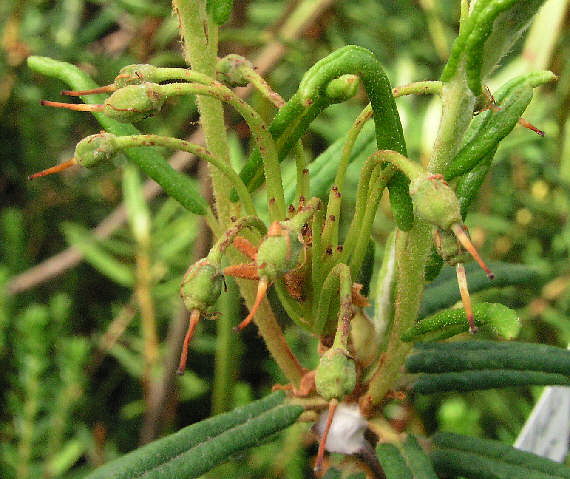
| Paluu dokumenttiluetteloon / Back to the catalogue of various documents on rhododendrons |
Pollinations in 2004 using
Rhododendron tomentosum
as Seed Plant
Kristian Theqvist, 25-Nov-2005, rev. 012
The table lists the
lepidotes that I have used as pollen giving plant in 2004.
The number of seeds for each cross is shown graphically in picture Number of Seeds.
The germination of seeds five weeks after sowing is shown in the rightmost column of the table. A maximum of 30 seeds were sown for each cross.
| Pollen parent |
Subsection |
Origin of pollen |
Seedpods swelling? |
Number of seeds 26-Oct-2004 |
Germination of seeds out of max 30 seeds 18-Jan-2005 |
| ambiguum |
Triflora |
Copenhagen | Yes |
40 seeds |
12/30 seed plants |
| augustinii |
Triflora |
Copenhagen | Maybe? |
8 small seeds |
1/8 seed plant |
| augustinii 'Aquamarin' |
Triflora x |
Own plant from Hachmann | No |
No seed |
- |
|
'Biskra' (cinnabarinum Roylei Group x ambiguum) |
Cinnabarina x Triflora |
Jens Birck | Yes |
22 seeds |
12/22 seed plants |
| 'Biskra' x cinnabarinum var. xanthocodon |
(Cinnabarina x Triflora) x Cinnabarina |
Jens Birck | Yes |
15 seeds |
1/15 seed plant |
| calostrotum ssp. keleticum |
Saluenensia |
Own plant from Rhododendron-Haven | Yes |
6 weak seeds, very little pollen |
None |
| concinnum |
Triflora |
Own plant from Glendoick | Yes |
10 seeds, some weak |
2/10 seed plants |
| concinnum |
Triflora |
Copenhagen | - |
Twig broken. Moose? |
- |
| concinnum var. pseudoyanthinum |
Triflora |
Sofiero | Maybe? |
4 seeds |
3/4 seed plants |
| impeditum |
Lapponica |
Own plant from Helsinki Garden Fair | Yes |
45 seeds |
13/30 seed plants |
|
'Isola Bella' (dauricum 'Artic Pearl' selfed) x fletcherianum 'Yellow Bunting' |
(Rhodorastra x) x (Maddenia x) |
Own plant from Glendoick | Yes |
10 seeds |
3/10 seed plants |
| keiskei 'Yaku Fairy' |
Triflora |
Own plant from Glendoick | Yes |
11 seeds |
4/11 seed plants |
| lapponicum var. parvifolium |
Lapponica |
Bergianska | Yes |
9 seeds |
4/9 seed plants |
| lapponicum, New Foundland |
Lapponica |
Own plant from Bengt Kihlman | Yes |
No seed, very little pollen |
- |
| leucaspis |
Boothia |
Gothenburg | Yes |
80 seeds |
24/30 seed plants |
| 'Milky Way' | Ledum | Own plant from Glendoick | Yes |
150 seeds |
27/30 seed plants |
| oreotrephes | Oreotrephes alliance | Gothenburg | No |
No seed |
- |
|
'Princess Anne' (picture © Glendoick
Gardens) (hanceanum x keiskei) |
Tephropepla x Triflora | Kari Nikulainen / Glendoick | Yes |
10 seed |
6/10 seed plants |
| russatum | Lapponica | Gothenburg | Yes |
10 seed |
3/10 seed plants |
| russatum var. cantabile | Lapponica | Own plant from Rhododendron-Haven | Yes |
100 seeds, small |
1/30 seed plant |
| saluenense | Saluenensia | Bergianska | Yes |
65 seeds |
19/30 seed plants |
| sargentianum | Pogonanthum | Own plant from Hvidbjerg Planteskole | No |
Surprise, 6 very small seeds, very little pollen |
None |
| trichostomum 'Schneefl÷ckchen' | Pogonanthum x | Own plant from Rhododendron-Haven | Yes |
6 seeds |
None |
| spinuliferum (picture at www.rhododendron.dk, taken by Hank Helm) | Scabrifolia | Hank Helm | Maybe? |
No seed |
- |
| spinuliferum | Scabrifolia | June Sinclair (John Weagle) | Maybe? |
8 very small, weak looking seeds |
6/8 seed plants |
| tapetiforme |
Lapponica |
Copenhagen | Yes |
40 seeds |
6/30 seed plants |
| subarcticum |
Ledum |
Own plant from Hvidbjerg Planteskole | Yes |
3 small seeds, very little pollen |
None |
| veitchianum |
Maddenia |
Don Hyatt | Yes |
50 seeds (pollen in freezer) + 16 seeds (pollen in fridge) |
18/30 seed plants |
| yungningense | Lapponica | Gothenburg | Yes |
9 seeds |
1/9 seed plant |
| yunnanense | Triflora | Gothenburg | Yes |
83 seeds |
13/30 seed plants |
A total of 30 crossings of which surprisingly many seems to yield seed.
I made the first pollination 12-Jun-2004 on emasculated and covered flowers. The stigmas were not all receptive at that time and when checking the result one week later only approx. 50 % of the total 310 stigmas had taken. After re-pollination (on the now receptive stigmas) the result looked clearly better.
22 of the crossings have clearly swelled seedpods and three crossings does not seem to yield any seed. Four of the crossings have only slightly swelled seedpods and it is difficult to say whether they actually contain any seeds.One crossing failed because the twig was broken, possibly by a moose walking over my crossings.

|
| Figure 1. Swelling and elongating ovaries on the cross tomentosum x veitchianum three weeks after pollination. Very interesting cross! I now only hope that it yields in viable seeds and plants. |
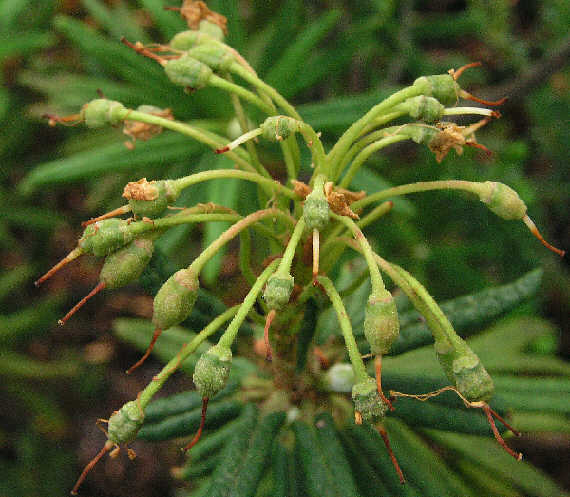
|
| Figure 2. Wild, open-pollinated tomentosum is shown here as reference. As can be seen there are several apparantly non-pollinated pods that does not yield in any seeds. Day temperatures were pretty low in June and may have affected the not-so-good result of open-pollination. |
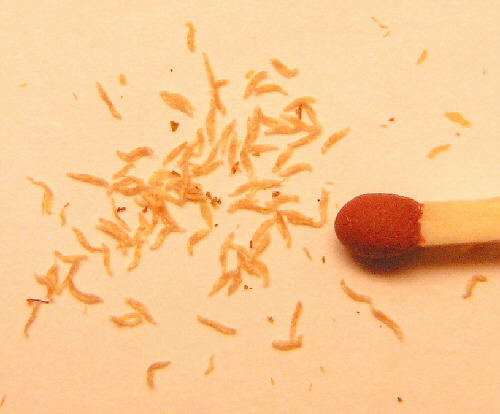
|
| Figure 3. Seeds from the cross tomentosum x yunnanense. |
Status 26-Oct-2004 on tomentosum 2004 crosses
Almost all crosses yielded seed as was anticipated from the swelling seed pods. The amount of the seed varied from cross to cross. The seeds were on most of the crosses very viable looking and with
variation in outlook (width, crookedness). On some crosses there were only few seeds and the seeds were small and weak looking.
I had pollinated ten stigmas for each cross. The
number of seeds is shown in the graph of figure 4.
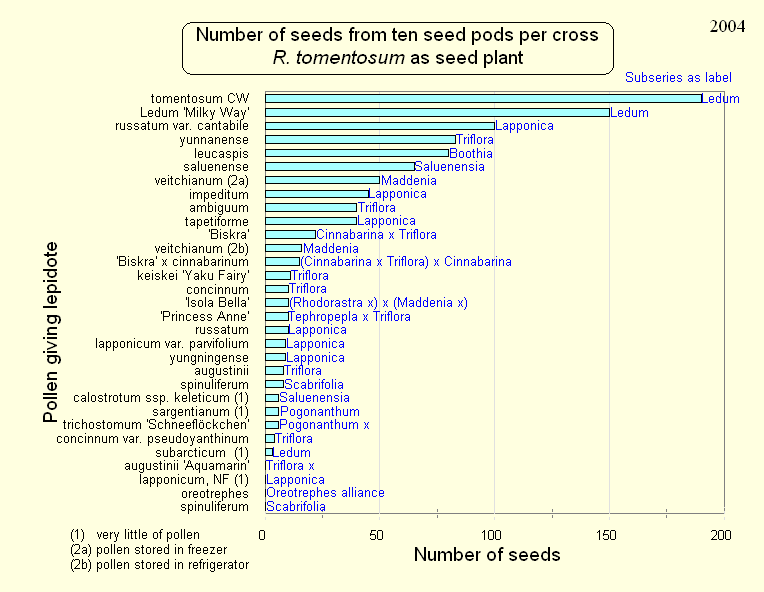 |
|
Figure 4. Number of seeds from the crosses. |
Clearly wild pollinated tomentosum gave seed best, approx. 19 seeds/pod. Second most came from the Ledum
'Milky Way' (15 seeds/pod). This was close to expected. Next came russatum var. cantabile from the
Lapponica subsection (10 seeds/pod). After that came the first interesting surprises:
yunnanense from Triflora and
leucaspis from Boothia (8 seeds/pod)!
I had made a note on four pollinations that there was very little pollen. It was a relief to note that all those four gave no seed or very little seed. Clearly at least subarcticum and lapponicum as pollinator should have given more seed, if there only had been enough pollen.
Some of the R. veitchianum pollen was stored in refrigerator to see whether that gives any difference in germination when compared to pollen stored in freezer. Pollen
stored in freezer yielded three times more seed. However, there are so many other factors affecting germination that no distinctive conclusions can be made on this small sample
basis.
Status 18-Jan-2005 on tomentosum 2004 crosses
I did sow the seeds on the 11-Dec-2004, maximum 30 seeds of each cross and also tomentosum CW as reference. The seeds started to germinate already one week after sowing and the first true leaves started growing four weeks after sowing. The germination result wasn't good for all crosses, but still there are some really interesting seed plants growing.
Last year I noted that the germination of seeds was very low on the crosses with dauricum and ledebourii, but good for example on the strange cross with cinnabarinum. Now the germination was unexpexted low on the crosses with russatum, russatum var. cantabile and impeditum, but good on some more exotic crosses like leucaspis, veitchianum and spinuliferum. Why? Is this only coincidence with too little data? I have some thoughts on the reasons, but I need study this more before I'll publish any theories.
Status 10-Mar-2005 on tomentosum 2004 crosses
The seed plants are 3 months old and have already several true leaves. The crossings start to show hybrid features. The growth is on some plants very vigorous, but on some very slow when compared to tomentosum CW reference plants. The shape of the leaves is on some crossings wide, almost round. A example on this is a tomentosum x spinuliferum seed plant as shown in Figure 5.
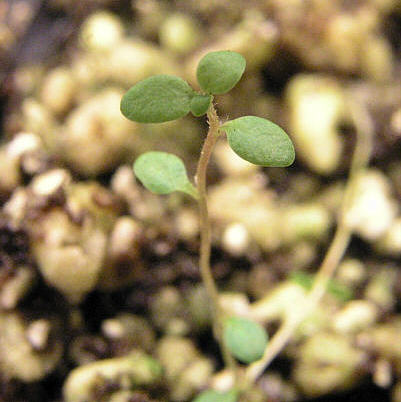
|
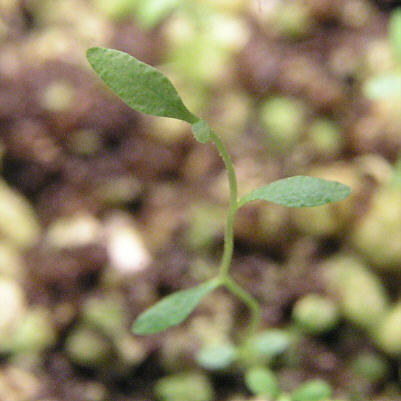 |
| Figure 5. A three month old tomentosum x spinuliferum seed plant has almost round leaves. | Figure 6. A tomentosum CW seed plant with very typical leaves is shown here as reference. |
Status 27-Apr-2005 on tomentosum 2004 crosses
The seed plants are 20 weeks old and start to show individual characteristics.
As expected the features from mother R. tomentosum are seen strongly on most of the seed plants.
However, there are several plants that show clear hybrid features and differ considerably from R. tomentosum.
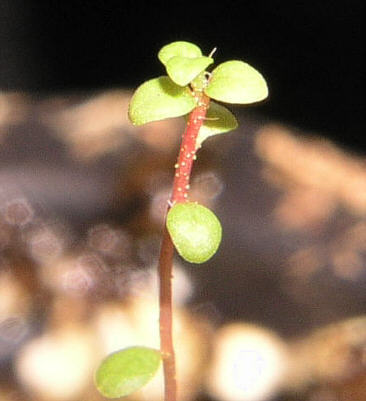
|
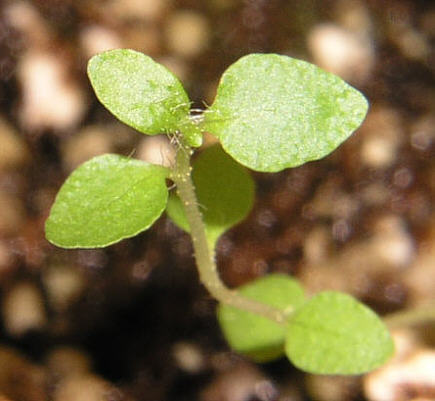 |
| Figure 7. A 20 weeks old R. tomentosum x leucaspis seed plant has orange red stalk and small roundish leaves. | Figure 8. R. tomentosum x concinnum var. pseudoyanthinum seed plant has almost triangular shaped leaves. |
Status 25-Oct-2005 on tomentosum 2004 crosses
The seed plants are now 41 weeks old.
I had the plants out during the summer but now they are again in my workroom in controlled conditions.
The seed plants suffered during summer from a rust fungi, spruce needle rust (Chrysomyxa ledi) which is quite common on R. tomentosum during wet summers.
Unfortunately this weakened the growth in summer time. The plants are now luckily clean of the rust and are growing well.
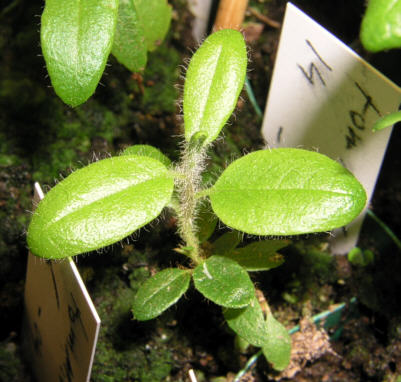 |
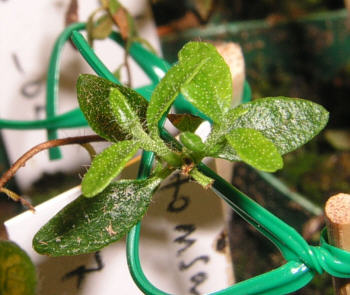 |
| Figure 8. R. tomentosum x 'Milky Way' seed plants have considerably wider leaves than wild R. tomentosum. | Figure 9. R. tomentosum x saluenense seed plant has got features from the pollen given R. saluenense. |
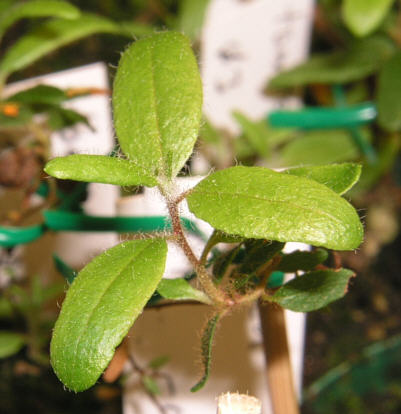 |
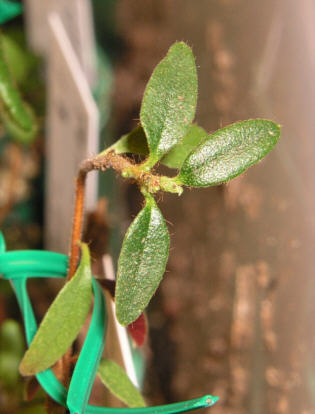 |
| Figure 10. R. tomentosum x leucaspis seed plant. | Figure 11. R. tomentosum x impeditum seed plant. |
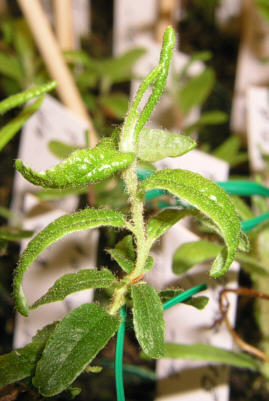 |
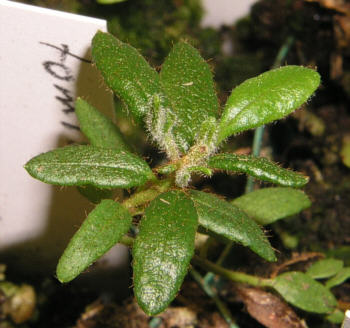 |
| Figure 12. R. tomentosum x concinnum seed plant. | Figure 13. R. tomentosum x yunnanense seed plant. |
Status 25-Nov-2005 on tomentosum 2004 crosses
The seed plants are now 45 weeks old.
The plants have continued their growth cycle and show different type of characteristics.
However, most of the plants resemble more the mother R. tomentosum than the pollen giving lepidote.
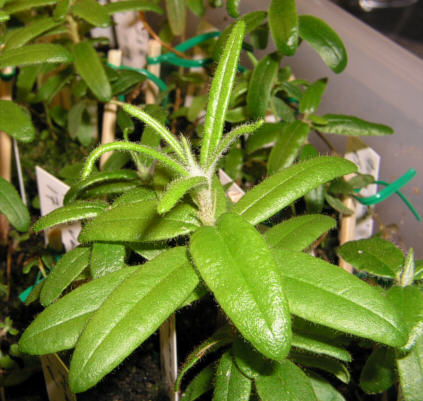 |
| Figure 14. R. tomentosum x 'Milky Way' seed plants have the strongest growth when compared to any other cross. The plants look very similar in habit to the R. tomentosum x groenlandicum cross plants that I made in 2003. I do have strong belief (based partly on discussions with Bengt Kihlman) that 'Milky Way' is not a true selection of R. tomentosum but rather could be a natural cross between R. groenlandicum and R. subarcticum. Anyway, 'Milky Way' is a beautiful Ledum and it gives very vigorous plants when crossing it with R. tomentosum. |
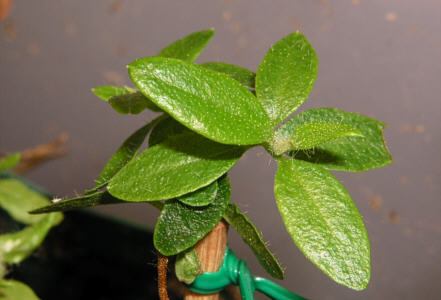 |
| Figure 15. R. tomentosum x saluenense seed plant is showing features from the pollen given R. saluenense. The leaves are short and almost glabrous. |
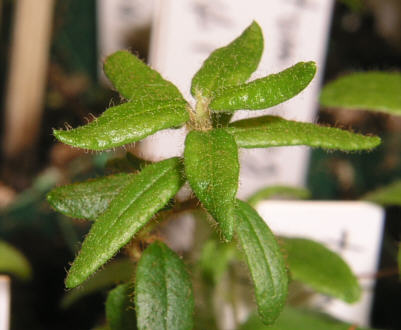 |
| Figure 16. R. tomentosum x spinuliferum seed plant has slow growth and the leaves are twisted and slightly malformed. Incompatibility in the chromosomes? |
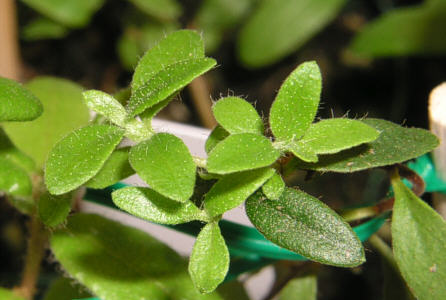 |
| Figure 17. R. tomentosum x impeditum seed plant has very nice looking small leaves that resemble R. impeditum leaves. |
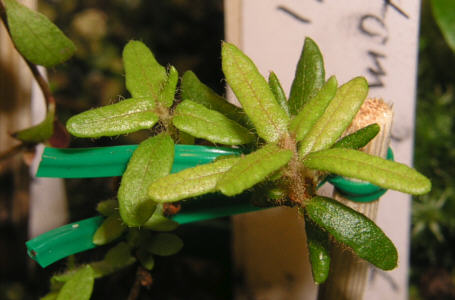 |
| Figure 18. R. tomentosum x lapponicum var. Parvifolium Group seed plant has small leaves and slow growth. |
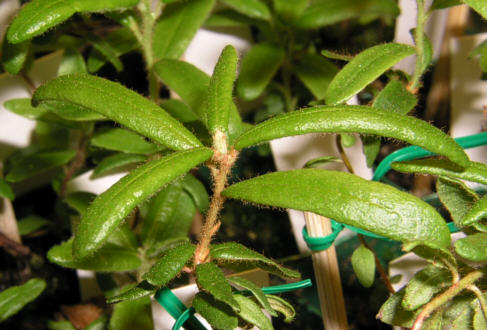 |
| Figure 19. R. tomentosum x yunnanense seed plant has long and narrow leaves. The resemblence to R. tomentosum is very apparent. |
I'll report on the growth of the seedlings on this page whenever something worthwhile reporting happens.
Lepidote Crosses in 2003 using Rhododendron tomentosum as Seed Plant
Hybridity of lepidotes in Rhododendron subsection Ledum based on some hybridization results
Taxonomy of species in Rhododendron subsection Ledum
Breeding Hardy Elepidote Rhododendrons in Finland